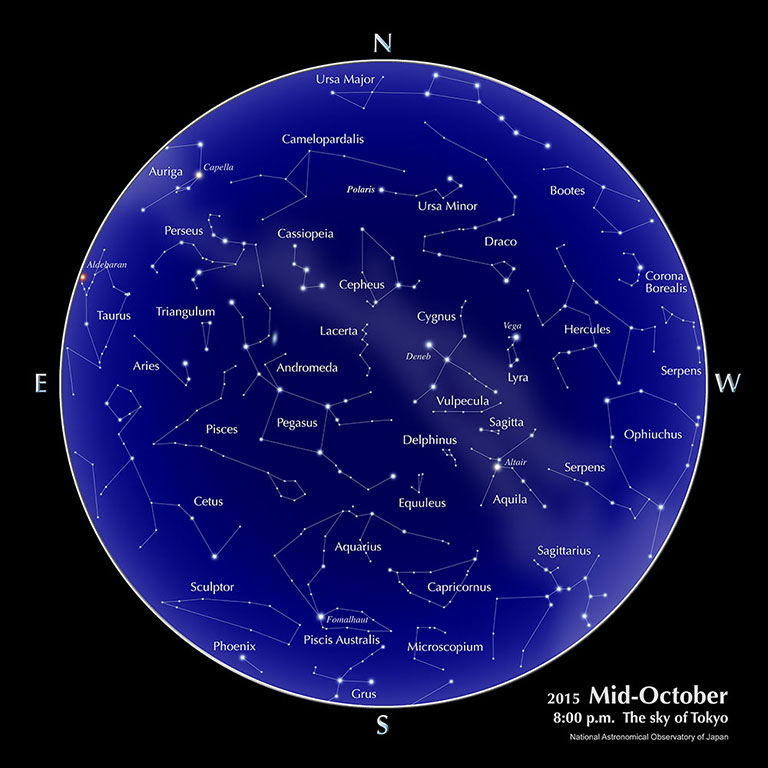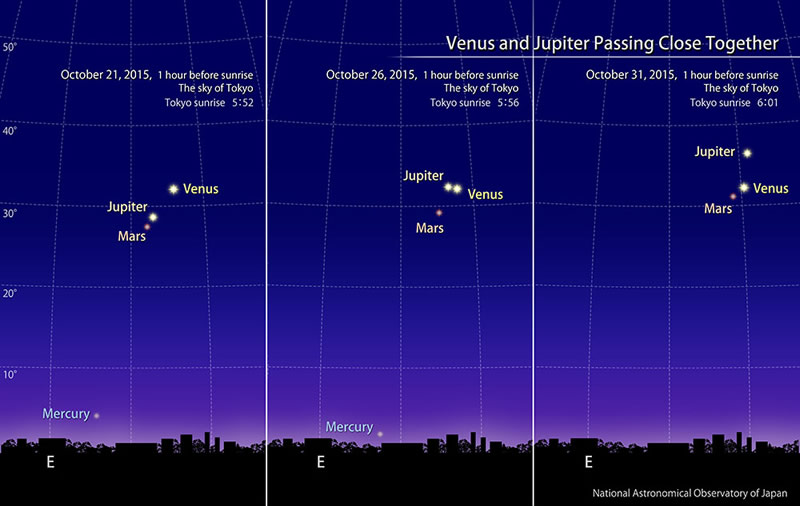October, 2015
Index
The sky of Tokyo

Calendar (October)
| 5 | Last Quarter |
| 9 | Mercury at stationary point / Peak of October Draconids Meteor Shower (There is no effect of moonlight.) |
| 10 | Peak of Southern Taurids Meteor Shower (There is no effect of moonlight) |
| 12 | Uranus at opposition / Health Sports Day (National holiday) |
| 13 | New Moon |
| 16 | Greatest Western Elongation of Mercury |
| 21 | First Quarter / Peak of Orionids Meteor Shower (The moon sets around mid of the night) |
| 26 | Greatest Western Elongation of Venus |
| 27 | Full Moon |
The posted peak day and time of meteor showers is based on the prediction of IMO(International Meteor Organization).
Planets
- Mercury
- Mercury is located low in the eastern sky before sunrise. It reaches its greatest western elongation on the 16th. For several days around this date, the elevation is over 10 degrees at 30 minutes before sunrise, making it easy to observe. The brightness for the week centered on the greatest western elongation is -0.1 magnitude to -0.7 magnitude.
- Venus
- Venus shines particularly brightly in the eastern sky before sunrise. It reaches its greatest western elongation on the 26th. The brightness is -4.5 magnitude to -4.4 magnitude.
- Mars
- Mars, located in the constellation Leo, can be seen in the eastern sky before sunrise. The brightness is 1.8 magnitude to 1.7 magnitude.
- Jupiter
- Jupiter, located in the constellation Leo, shines brightly in the eastern sky before sunrise. The brightness is -1.7 magnitude to -1.8 magnitude.
- Suturn
- Saturn moves from the constellation Libra to the constellation Scorpius. It is located low in the southwestern sky after sunset. At the end of the month, its apparent location moves close to the Sun, making observations difficult. The brightness is 0.6 magnitude to 0.5 magnitude.
Source: Ephemeris Computation Office, NAOJ
With the “Sky Viewer” you can easily explore the appearance of a typical urban night sky (planets and constellations are visible).The Celestial Phenomenasection of the glossary explains the planetary phenomena terms: greatest elongation, opposition, conjunction, stationary, etc.
Topics
The Moon Passing Close to Venus, Mars, and Jupiter

The -4th magnitude ‘Morning Star,’ Venus, stands out shining brightly in the eastern sky before sunrise.
In the first part of October, Mars and Jupiter can be found in the sky below Venus. The brightness of Mars is a little dim at 1.8 magnitude. Jupiter is -1.7 magnitude. Being bright and low in the sky, they stand out.
On October 8, 9, and 10 the thin Moon can be seen close to these 3 planets, making a beautiful spectacle.
Venus and Jupiter Passing Close Together

Pay attention to changes in the positions of Venus, Mars and Jupiter which can be seen in the eastern sky before sunrise.
Jupiter, which is located low in the sky in the first part of October, slowly rises in elevation. It appears close to Mars around the 18th and appears close to Venus around the 26th. The close approach of Jupiter and Venus is particularly eye catching. It is likely to be a beautiful view.
Please get up early to watch.